Masters in Education: Leadership, Management, and Social Policy
VerifiedAdded on 2023/03/31
|9
|1657
|167
Essay
AI Summary
This essay provides an overview of educational leadership and management within a Masters in Education program. It discusses the importance of leadership and management in educational settings, exploring various leadership model theories such as transformative leadership, leader-member exchange theory, adaptive leadership theory, strength-based leadership theory, and servant leadership theory. The essay emphasizes the importance of teamwork, its advantages and disadvantages, and the concept of distributed leadership. It also addresses managing change in an institution, including responses to change and strategies for overcoming resistance. Furthermore, the essay touches on strategic management, social policy, educational leadership, social justice, and the role of leadership in achieving educational quality. The conclusion reiterates the significance of effective leadership and management in educational institutions and encourages teamwork, staff involvement in decision-making, and the use of targets as motivation for teachers and students.
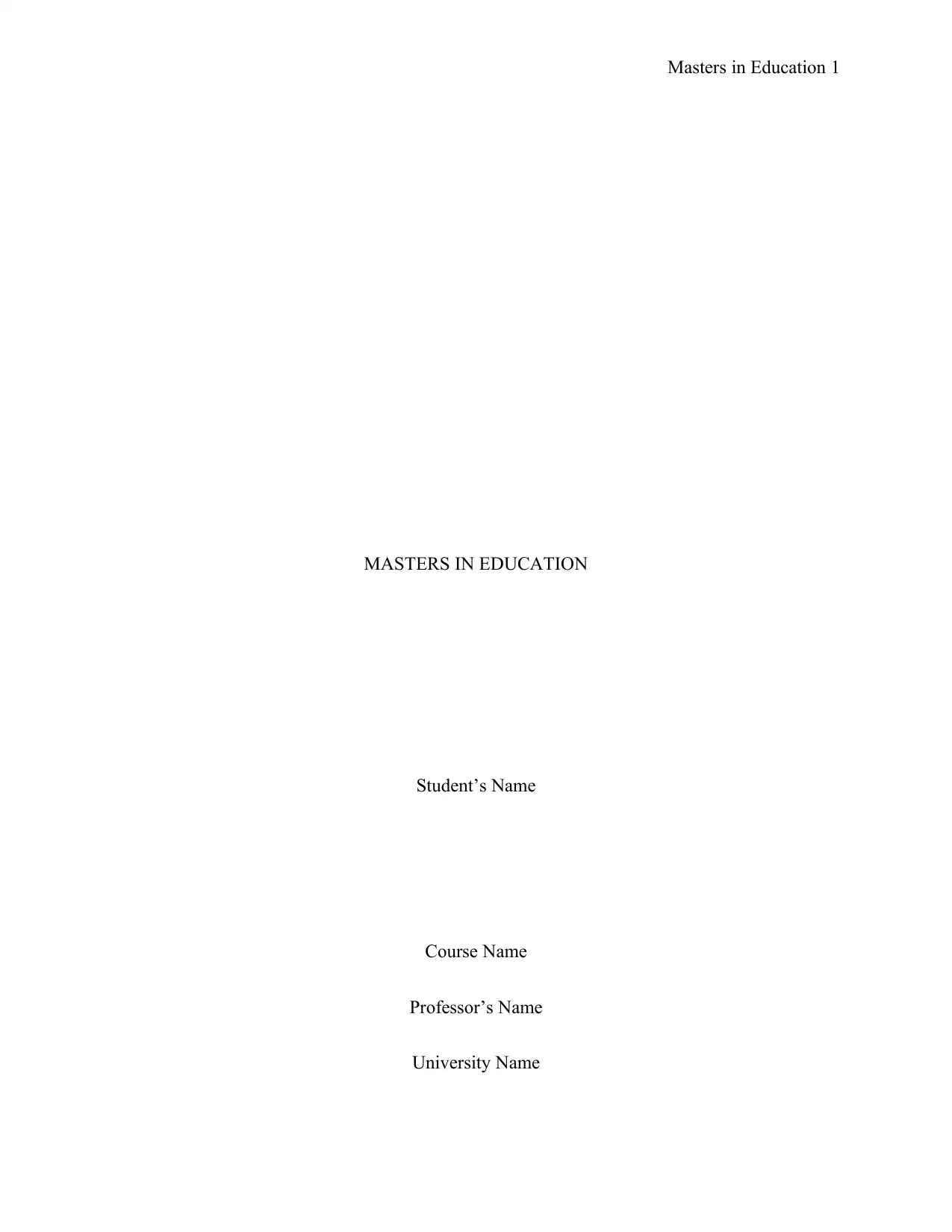
Masters in Education 1
MASTERS IN EDUCATION
Student’s Name
Course Name
Professor’s Name
University Name
MASTERS IN EDUCATION
Student’s Name
Course Name
Professor’s Name
University Name
Paraphrase This Document
Need a fresh take? Get an instant paraphrase of this document with our AI Paraphraser

Masters in Education 2
City, State
Date
City, State
Date
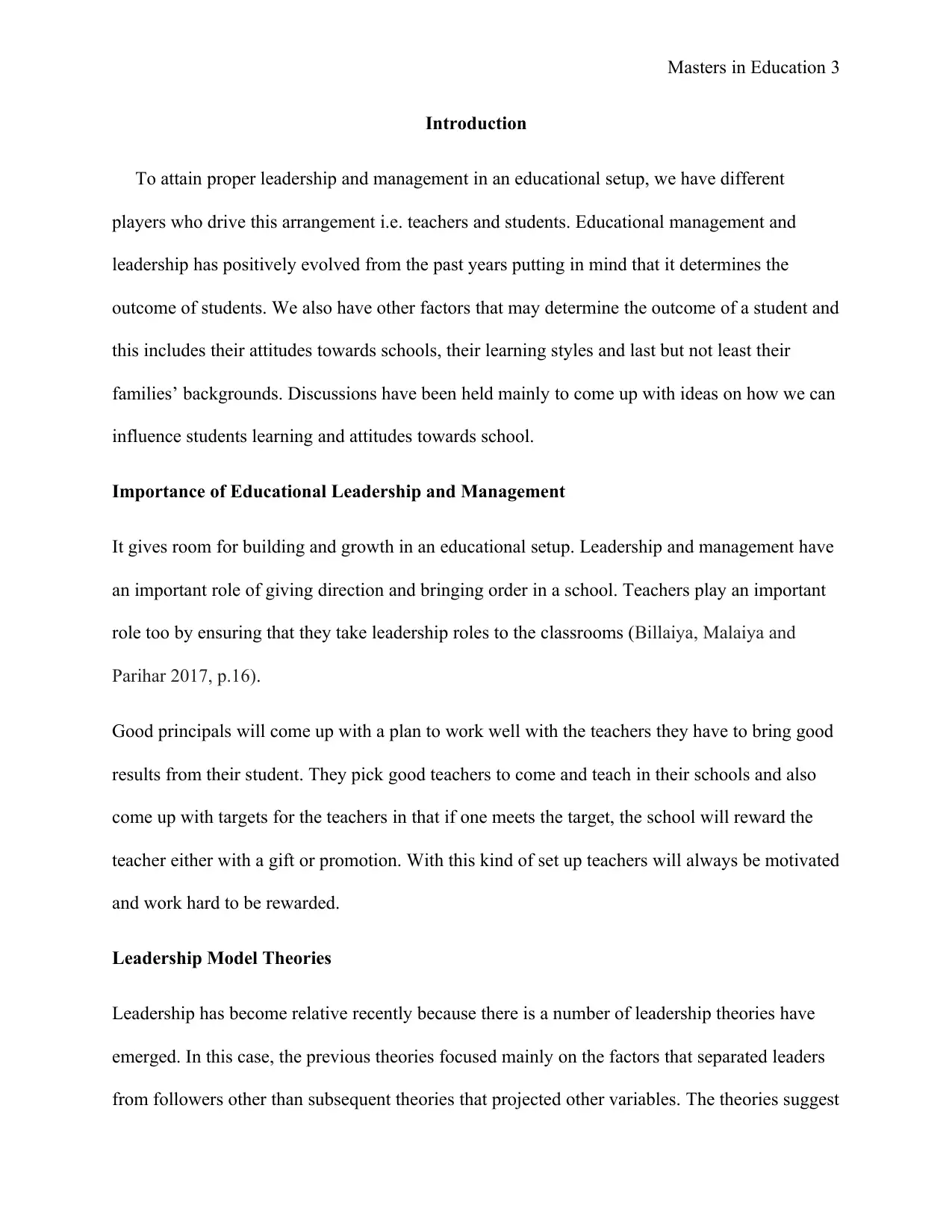
Masters in Education 3
Introduction
To attain proper leadership and management in an educational setup, we have different
players who drive this arrangement i.e. teachers and students. Educational management and
leadership has positively evolved from the past years putting in mind that it determines the
outcome of students. We also have other factors that may determine the outcome of a student and
this includes their attitudes towards schools, their learning styles and last but not least their
families’ backgrounds. Discussions have been held mainly to come up with ideas on how we can
influence students learning and attitudes towards school.
Importance of Educational Leadership and Management
It gives room for building and growth in an educational setup. Leadership and management have
an important role of giving direction and bringing order in a school. Teachers play an important
role too by ensuring that they take leadership roles to the classrooms (Billaiya, Malaiya and
Parihar 2017, p.16).
Good principals will come up with a plan to work well with the teachers they have to bring good
results from their student. They pick good teachers to come and teach in their schools and also
come up with targets for the teachers in that if one meets the target, the school will reward the
teacher either with a gift or promotion. With this kind of set up teachers will always be motivated
and work hard to be rewarded.
Leadership Model Theories
Leadership has become relative recently because there is a number of leadership theories have
emerged. In this case, the previous theories focused mainly on the factors that separated leaders
from followers other than subsequent theories that projected other variables. The theories suggest
Introduction
To attain proper leadership and management in an educational setup, we have different
players who drive this arrangement i.e. teachers and students. Educational management and
leadership has positively evolved from the past years putting in mind that it determines the
outcome of students. We also have other factors that may determine the outcome of a student and
this includes their attitudes towards schools, their learning styles and last but not least their
families’ backgrounds. Discussions have been held mainly to come up with ideas on how we can
influence students learning and attitudes towards school.
Importance of Educational Leadership and Management
It gives room for building and growth in an educational setup. Leadership and management have
an important role of giving direction and bringing order in a school. Teachers play an important
role too by ensuring that they take leadership roles to the classrooms (Billaiya, Malaiya and
Parihar 2017, p.16).
Good principals will come up with a plan to work well with the teachers they have to bring good
results from their student. They pick good teachers to come and teach in their schools and also
come up with targets for the teachers in that if one meets the target, the school will reward the
teacher either with a gift or promotion. With this kind of set up teachers will always be motivated
and work hard to be rewarded.
Leadership Model Theories
Leadership has become relative recently because there is a number of leadership theories have
emerged. In this case, the previous theories focused mainly on the factors that separated leaders
from followers other than subsequent theories that projected other variables. The theories suggest
⊘ This is a preview!⊘
Do you want full access?
Subscribe today to unlock all pages.

Trusted by 1+ million students worldwide
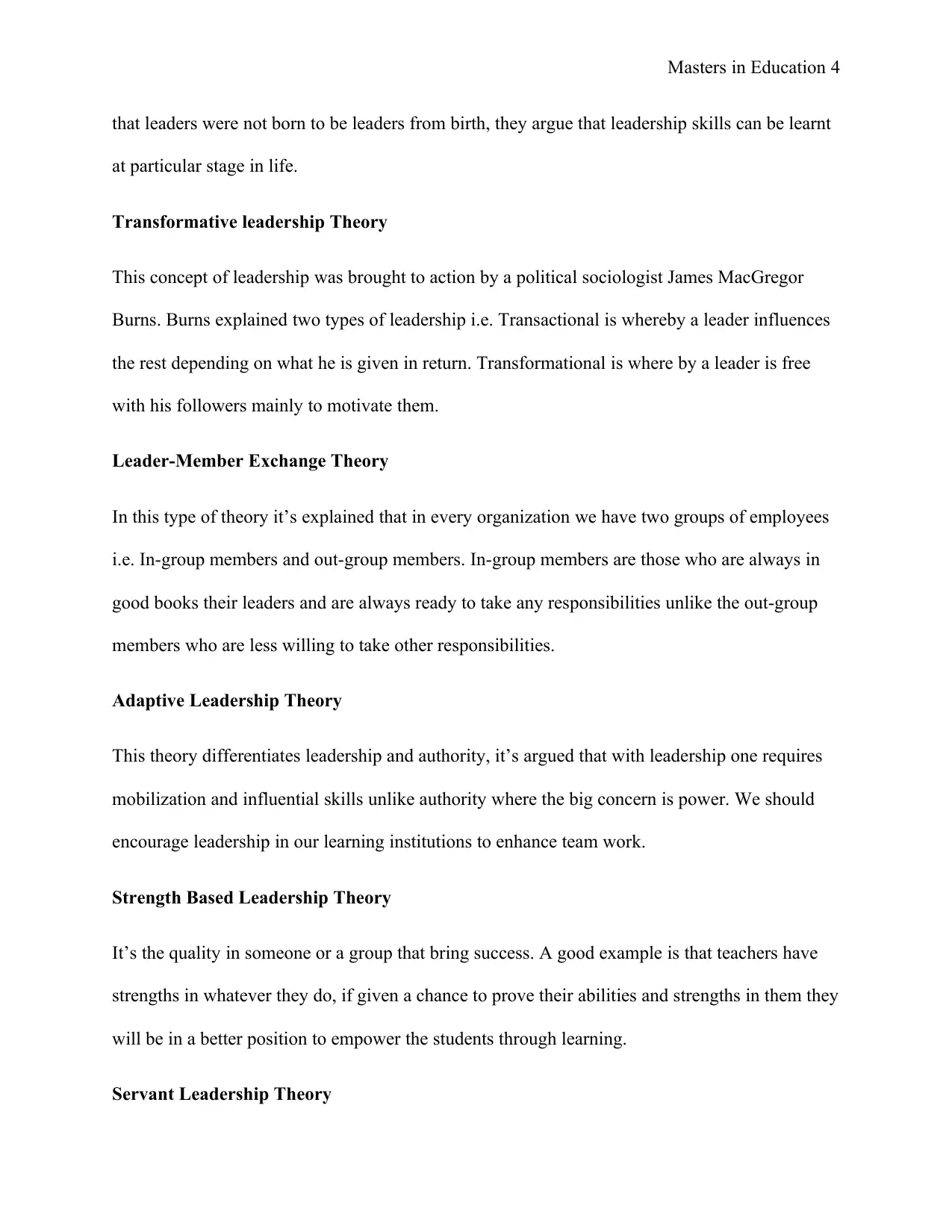
Masters in Education 4
that leaders were not born to be leaders from birth, they argue that leadership skills can be learnt
at particular stage in life.
Transformative leadership Theory
This concept of leadership was brought to action by a political sociologist James MacGregor
Burns. Burns explained two types of leadership i.e. Transactional is whereby a leader influences
the rest depending on what he is given in return. Transformational is where by a leader is free
with his followers mainly to motivate them.
Leader-Member Exchange Theory
In this type of theory it’s explained that in every organization we have two groups of employees
i.e. In-group members and out-group members. In-group members are those who are always in
good books their leaders and are always ready to take any responsibilities unlike the out-group
members who are less willing to take other responsibilities.
Adaptive Leadership Theory
This theory differentiates leadership and authority, it’s argued that with leadership one requires
mobilization and influential skills unlike authority where the big concern is power. We should
encourage leadership in our learning institutions to enhance team work.
Strength Based Leadership Theory
It’s the quality in someone or a group that bring success. A good example is that teachers have
strengths in whatever they do, if given a chance to prove their abilities and strengths in them they
will be in a better position to empower the students through learning.
Servant Leadership Theory
that leaders were not born to be leaders from birth, they argue that leadership skills can be learnt
at particular stage in life.
Transformative leadership Theory
This concept of leadership was brought to action by a political sociologist James MacGregor
Burns. Burns explained two types of leadership i.e. Transactional is whereby a leader influences
the rest depending on what he is given in return. Transformational is where by a leader is free
with his followers mainly to motivate them.
Leader-Member Exchange Theory
In this type of theory it’s explained that in every organization we have two groups of employees
i.e. In-group members and out-group members. In-group members are those who are always in
good books their leaders and are always ready to take any responsibilities unlike the out-group
members who are less willing to take other responsibilities.
Adaptive Leadership Theory
This theory differentiates leadership and authority, it’s argued that with leadership one requires
mobilization and influential skills unlike authority where the big concern is power. We should
encourage leadership in our learning institutions to enhance team work.
Strength Based Leadership Theory
It’s the quality in someone or a group that bring success. A good example is that teachers have
strengths in whatever they do, if given a chance to prove their abilities and strengths in them they
will be in a better position to empower the students through learning.
Servant Leadership Theory
Paraphrase This Document
Need a fresh take? Get an instant paraphrase of this document with our AI Paraphraser
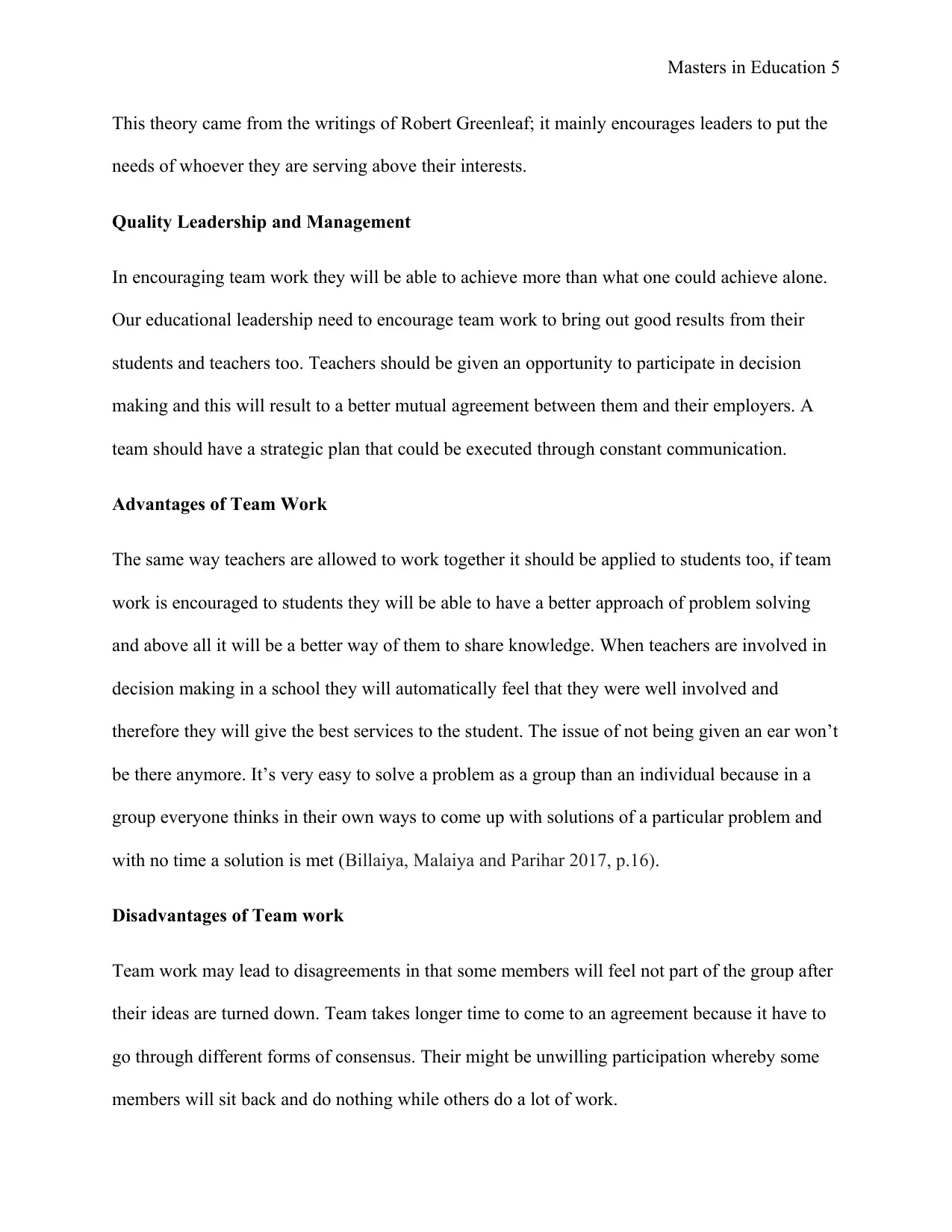
Masters in Education 5
This theory came from the writings of Robert Greenleaf; it mainly encourages leaders to put the
needs of whoever they are serving above their interests.
Quality Leadership and Management
In encouraging team work they will be able to achieve more than what one could achieve alone.
Our educational leadership need to encourage team work to bring out good results from their
students and teachers too. Teachers should be given an opportunity to participate in decision
making and this will result to a better mutual agreement between them and their employers. A
team should have a strategic plan that could be executed through constant communication.
Advantages of Team Work
The same way teachers are allowed to work together it should be applied to students too, if team
work is encouraged to students they will be able to have a better approach of problem solving
and above all it will be a better way of them to share knowledge. When teachers are involved in
decision making in a school they will automatically feel that they were well involved and
therefore they will give the best services to the student. The issue of not being given an ear won’t
be there anymore. It’s very easy to solve a problem as a group than an individual because in a
group everyone thinks in their own ways to come up with solutions of a particular problem and
with no time a solution is met (Billaiya, Malaiya and Parihar 2017, p.16).
Disadvantages of Team work
Team work may lead to disagreements in that some members will feel not part of the group after
their ideas are turned down. Team takes longer time to come to an agreement because it have to
go through different forms of consensus. Their might be unwilling participation whereby some
members will sit back and do nothing while others do a lot of work.
This theory came from the writings of Robert Greenleaf; it mainly encourages leaders to put the
needs of whoever they are serving above their interests.
Quality Leadership and Management
In encouraging team work they will be able to achieve more than what one could achieve alone.
Our educational leadership need to encourage team work to bring out good results from their
students and teachers too. Teachers should be given an opportunity to participate in decision
making and this will result to a better mutual agreement between them and their employers. A
team should have a strategic plan that could be executed through constant communication.
Advantages of Team Work
The same way teachers are allowed to work together it should be applied to students too, if team
work is encouraged to students they will be able to have a better approach of problem solving
and above all it will be a better way of them to share knowledge. When teachers are involved in
decision making in a school they will automatically feel that they were well involved and
therefore they will give the best services to the student. The issue of not being given an ear won’t
be there anymore. It’s very easy to solve a problem as a group than an individual because in a
group everyone thinks in their own ways to come up with solutions of a particular problem and
with no time a solution is met (Billaiya, Malaiya and Parihar 2017, p.16).
Disadvantages of Team work
Team work may lead to disagreements in that some members will feel not part of the group after
their ideas are turned down. Team takes longer time to come to an agreement because it have to
go through different forms of consensus. Their might be unwilling participation whereby some
members will sit back and do nothing while others do a lot of work.
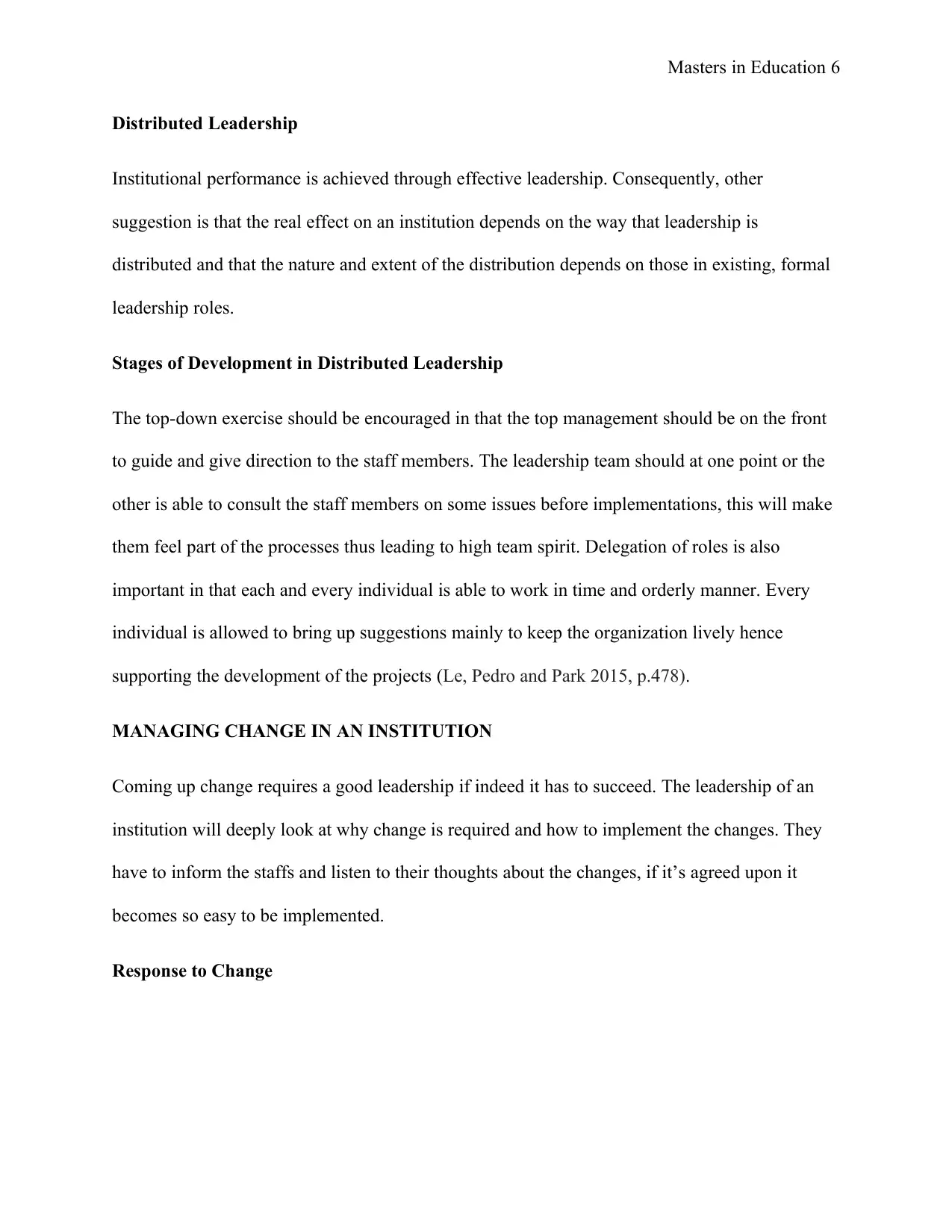
Masters in Education 6
Distributed Leadership
Institutional performance is achieved through effective leadership. Consequently, other
suggestion is that the real effect on an institution depends on the way that leadership is
distributed and that the nature and extent of the distribution depends on those in existing, formal
leadership roles.
Stages of Development in Distributed Leadership
The top-down exercise should be encouraged in that the top management should be on the front
to guide and give direction to the staff members. The leadership team should at one point or the
other is able to consult the staff members on some issues before implementations, this will make
them feel part of the processes thus leading to high team spirit. Delegation of roles is also
important in that each and every individual is able to work in time and orderly manner. Every
individual is allowed to bring up suggestions mainly to keep the organization lively hence
supporting the development of the projects (Le, Pedro and Park 2015, p.478).
MANAGING CHANGE IN AN INSTITUTION
Coming up change requires a good leadership if indeed it has to succeed. The leadership of an
institution will deeply look at why change is required and how to implement the changes. They
have to inform the staffs and listen to their thoughts about the changes, if it’s agreed upon it
becomes so easy to be implemented.
Response to Change
Distributed Leadership
Institutional performance is achieved through effective leadership. Consequently, other
suggestion is that the real effect on an institution depends on the way that leadership is
distributed and that the nature and extent of the distribution depends on those in existing, formal
leadership roles.
Stages of Development in Distributed Leadership
The top-down exercise should be encouraged in that the top management should be on the front
to guide and give direction to the staff members. The leadership team should at one point or the
other is able to consult the staff members on some issues before implementations, this will make
them feel part of the processes thus leading to high team spirit. Delegation of roles is also
important in that each and every individual is able to work in time and orderly manner. Every
individual is allowed to bring up suggestions mainly to keep the organization lively hence
supporting the development of the projects (Le, Pedro and Park 2015, p.478).
MANAGING CHANGE IN AN INSTITUTION
Coming up change requires a good leadership if indeed it has to succeed. The leadership of an
institution will deeply look at why change is required and how to implement the changes. They
have to inform the staffs and listen to their thoughts about the changes, if it’s agreed upon it
becomes so easy to be implemented.
Response to Change
⊘ This is a preview!⊘
Do you want full access?
Subscribe today to unlock all pages.

Trusted by 1+ million students worldwide
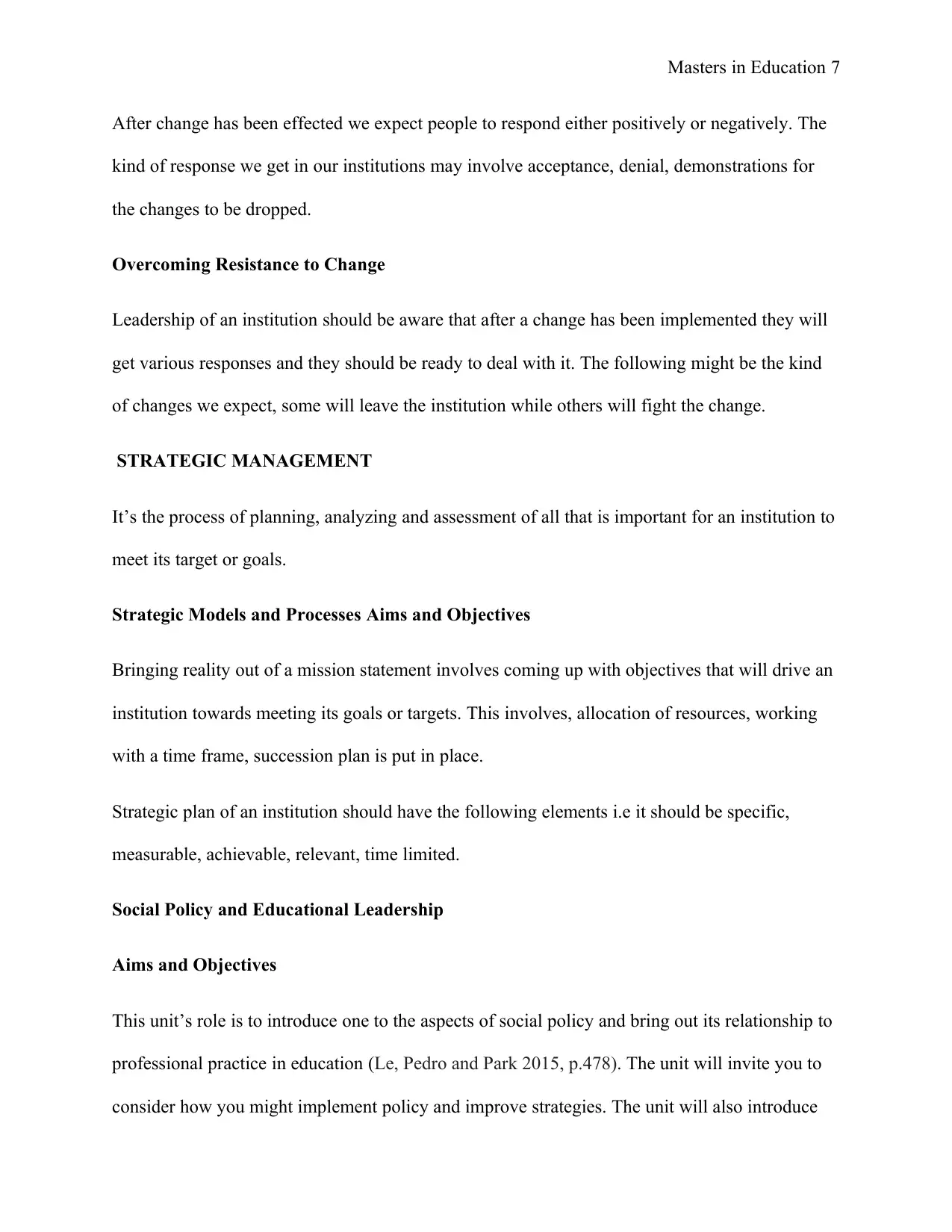
Masters in Education 7
After change has been effected we expect people to respond either positively or negatively. The
kind of response we get in our institutions may involve acceptance, denial, demonstrations for
the changes to be dropped.
Overcoming Resistance to Change
Leadership of an institution should be aware that after a change has been implemented they will
get various responses and they should be ready to deal with it. The following might be the kind
of changes we expect, some will leave the institution while others will fight the change.
STRATEGIC MANAGEMENT
It’s the process of planning, analyzing and assessment of all that is important for an institution to
meet its target or goals.
Strategic Models and Processes Aims and Objectives
Bringing reality out of a mission statement involves coming up with objectives that will drive an
institution towards meeting its goals or targets. This involves, allocation of resources, working
with a time frame, succession plan is put in place.
Strategic plan of an institution should have the following elements i.e it should be specific,
measurable, achievable, relevant, time limited.
Social Policy and Educational Leadership
Aims and Objectives
This unit’s role is to introduce one to the aspects of social policy and bring out its relationship to
professional practice in education (Le, Pedro and Park 2015, p.478). The unit will invite you to
consider how you might implement policy and improve strategies. The unit will also introduce
After change has been effected we expect people to respond either positively or negatively. The
kind of response we get in our institutions may involve acceptance, denial, demonstrations for
the changes to be dropped.
Overcoming Resistance to Change
Leadership of an institution should be aware that after a change has been implemented they will
get various responses and they should be ready to deal with it. The following might be the kind
of changes we expect, some will leave the institution while others will fight the change.
STRATEGIC MANAGEMENT
It’s the process of planning, analyzing and assessment of all that is important for an institution to
meet its target or goals.
Strategic Models and Processes Aims and Objectives
Bringing reality out of a mission statement involves coming up with objectives that will drive an
institution towards meeting its goals or targets. This involves, allocation of resources, working
with a time frame, succession plan is put in place.
Strategic plan of an institution should have the following elements i.e it should be specific,
measurable, achievable, relevant, time limited.
Social Policy and Educational Leadership
Aims and Objectives
This unit’s role is to introduce one to the aspects of social policy and bring out its relationship to
professional practice in education (Le, Pedro and Park 2015, p.478). The unit will invite you to
consider how you might implement policy and improve strategies. The unit will also introduce
Paraphrase This Document
Need a fresh take? Get an instant paraphrase of this document with our AI Paraphraser
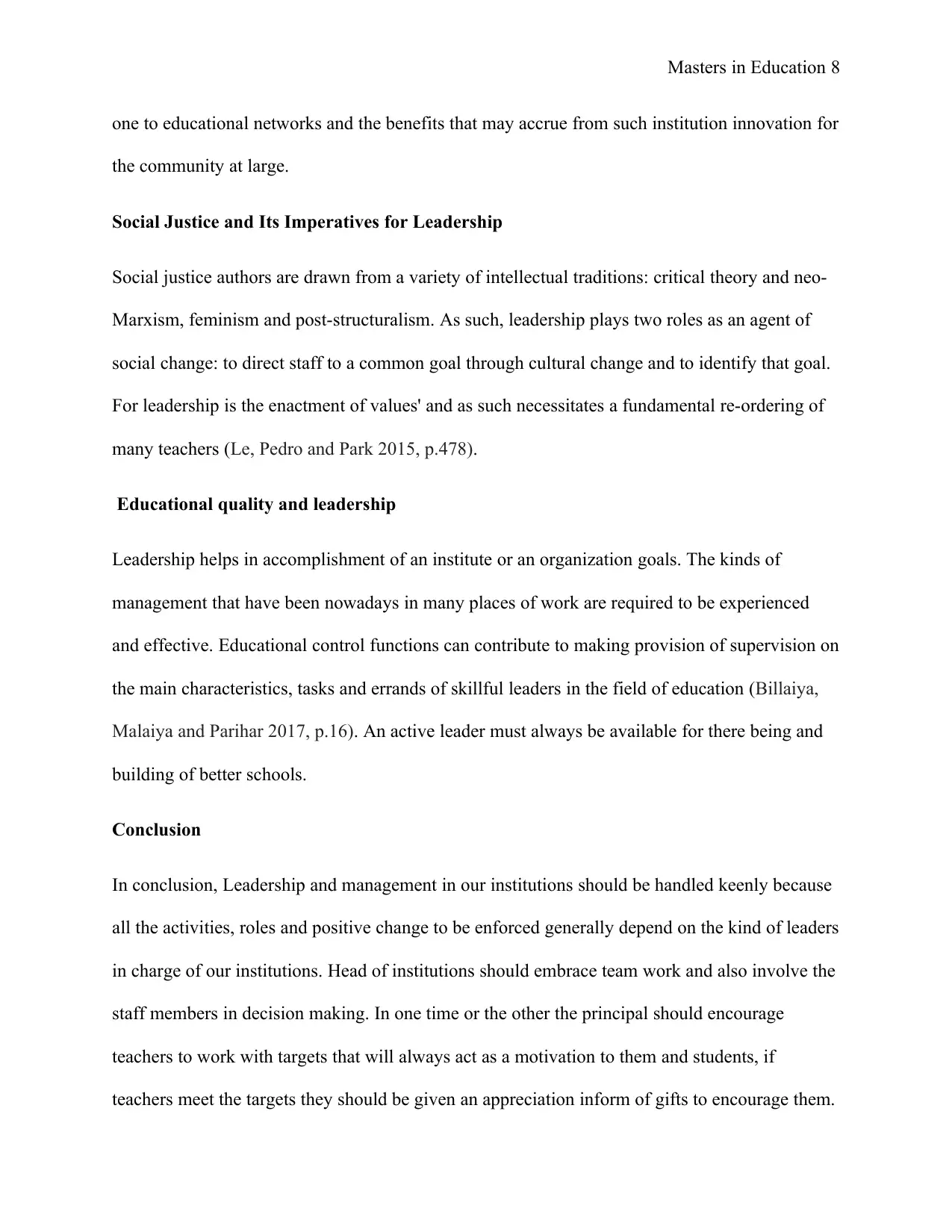
Masters in Education 8
one to educational networks and the benefits that may accrue from such institution innovation for
the community at large.
Social Justice and Its Imperatives for Leadership
Social justice authors are drawn from a variety of intellectual traditions: critical theory and neo-
Marxism, feminism and post-structuralism. As such, leadership plays two roles as an agent of
social change: to direct staff to a common goal through cultural change and to identify that goal.
For leadership is the enactment of values' and as such necessitates a fundamental re-ordering of
many teachers (Le, Pedro and Park 2015, p.478).
Educational quality and leadership
Leadership helps in accomplishment of an institute or an organization goals. The kinds of
management that have been nowadays in many places of work are required to be experienced
and effective. Educational control functions can contribute to making provision of supervision on
the main characteristics, tasks and errands of skillful leaders in the field of education (Billaiya,
Malaiya and Parihar 2017, p.16). An active leader must always be available for there being and
building of better schools.
Conclusion
In conclusion, Leadership and management in our institutions should be handled keenly because
all the activities, roles and positive change to be enforced generally depend on the kind of leaders
in charge of our institutions. Head of institutions should embrace team work and also involve the
staff members in decision making. In one time or the other the principal should encourage
teachers to work with targets that will always act as a motivation to them and students, if
teachers meet the targets they should be given an appreciation inform of gifts to encourage them.
one to educational networks and the benefits that may accrue from such institution innovation for
the community at large.
Social Justice and Its Imperatives for Leadership
Social justice authors are drawn from a variety of intellectual traditions: critical theory and neo-
Marxism, feminism and post-structuralism. As such, leadership plays two roles as an agent of
social change: to direct staff to a common goal through cultural change and to identify that goal.
For leadership is the enactment of values' and as such necessitates a fundamental re-ordering of
many teachers (Le, Pedro and Park 2015, p.478).
Educational quality and leadership
Leadership helps in accomplishment of an institute or an organization goals. The kinds of
management that have been nowadays in many places of work are required to be experienced
and effective. Educational control functions can contribute to making provision of supervision on
the main characteristics, tasks and errands of skillful leaders in the field of education (Billaiya,
Malaiya and Parihar 2017, p.16). An active leader must always be available for there being and
building of better schools.
Conclusion
In conclusion, Leadership and management in our institutions should be handled keenly because
all the activities, roles and positive change to be enforced generally depend on the kind of leaders
in charge of our institutions. Head of institutions should embrace team work and also involve the
staff members in decision making. In one time or the other the principal should encourage
teachers to work with targets that will always act as a motivation to them and students, if
teachers meet the targets they should be given an appreciation inform of gifts to encourage them.
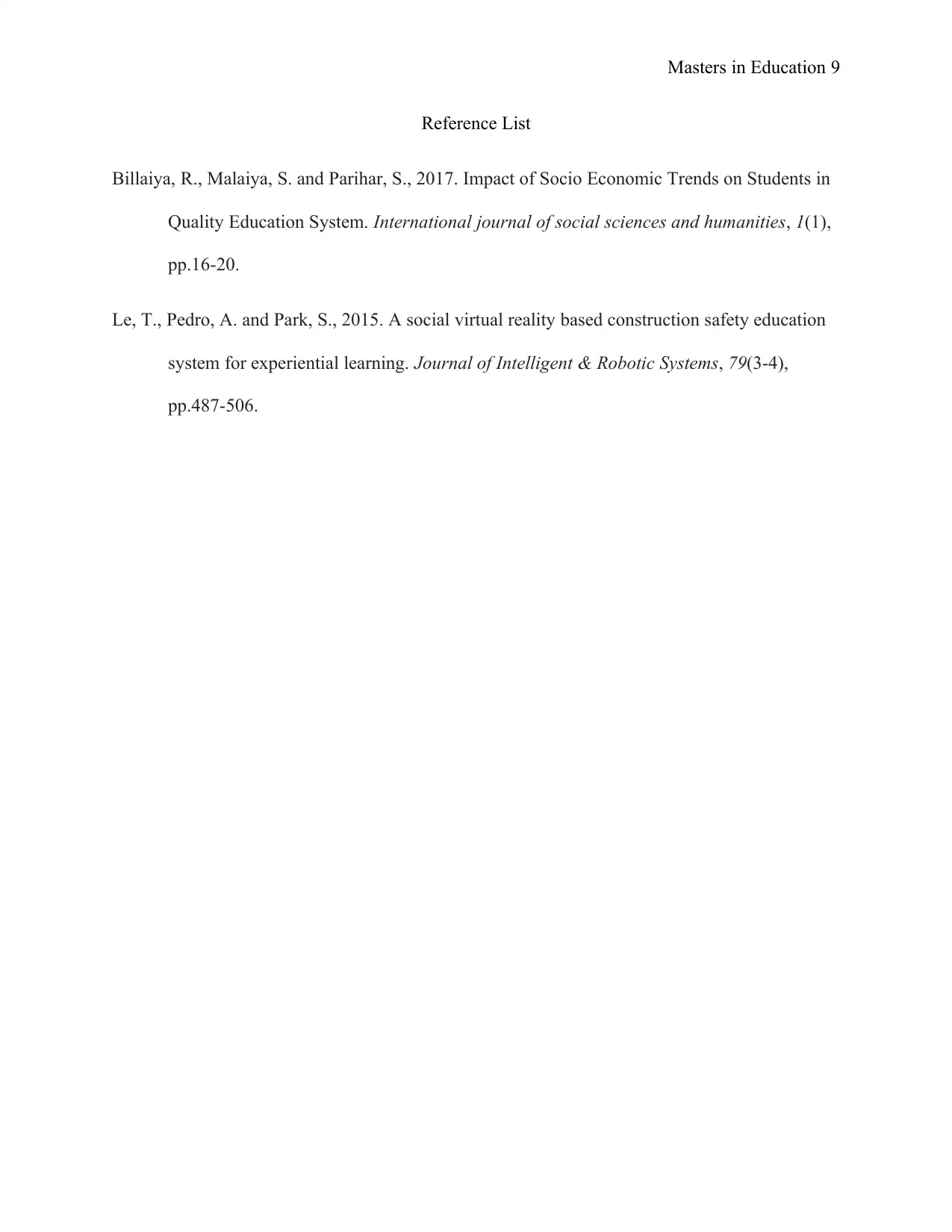
Masters in Education 9
Reference List
Billaiya, R., Malaiya, S. and Parihar, S., 2017. Impact of Socio Economic Trends on Students in
Quality Education System. International journal of social sciences and humanities, 1(1),
pp.16-20.
Le, T., Pedro, A. and Park, S., 2015. A social virtual reality based construction safety education
system for experiential learning. Journal of Intelligent & Robotic Systems, 79(3-4),
pp.487-506.
Reference List
Billaiya, R., Malaiya, S. and Parihar, S., 2017. Impact of Socio Economic Trends on Students in
Quality Education System. International journal of social sciences and humanities, 1(1),
pp.16-20.
Le, T., Pedro, A. and Park, S., 2015. A social virtual reality based construction safety education
system for experiential learning. Journal of Intelligent & Robotic Systems, 79(3-4),
pp.487-506.
⊘ This is a preview!⊘
Do you want full access?
Subscribe today to unlock all pages.

Trusted by 1+ million students worldwide
1 out of 9
Related Documents
Your All-in-One AI-Powered Toolkit for Academic Success.
+13062052269
info@desklib.com
Available 24*7 on WhatsApp / Email
![[object Object]](/_next/static/media/star-bottom.7253800d.svg)
Unlock your academic potential
Copyright © 2020–2025 A2Z Services. All Rights Reserved. Developed and managed by ZUCOL.





